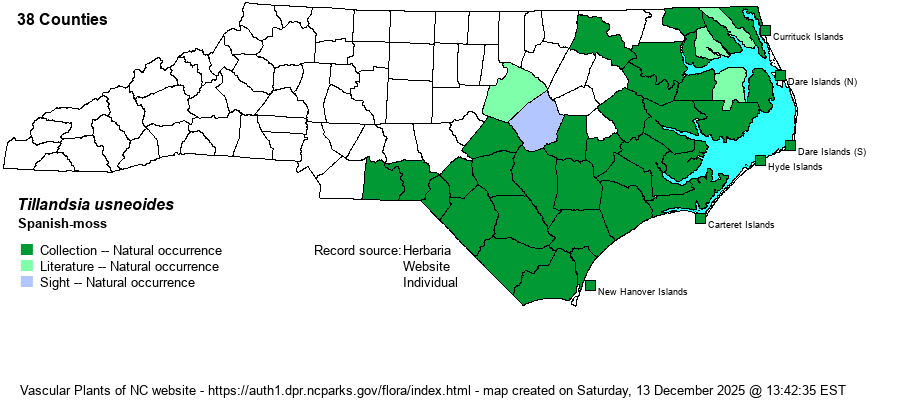| Author | (L.) L. | |
| Distribution | Nearly throughout the Coastal Plain, but scarce or of spotty occurrence in the northwestern counties. Barely extends into the Piedmont, along the Pee Dee River in Anson and Richmond Counties, and into eastern Wake County (at a cypress millpond). Scattered collections from farther west of Wake and Anson counties are presumed to represent transplanted clumps placed on trees; these are not mapped here.
This is a Southern Coastal Plain species, ranging north to southeastern VA, and south to the Gulf Coast and to southern TX. It barely ranges into the Piedmont. | |
| Abundance | Declining in the past 15-20 years owing to air pollution and a few other factors. Formerly common over the central and southern part of the range, but now still common in the southern third to half of the Coastal Plain but infrequent to fairly common in the central portions; rare to uncommon in the northern third of the Coastal Plain. | |
| Habitat | This species grows on limbs of trees, typically on hardwoods and cypresses, and most frequently in swamps and along rivers. However, it also grows on limbs and branches of trees in other humid air habitats, even in dry soil sites such as maritime forests and some coastal fringe sandhills. Nonetheless, the species favors humid conditions and is seldom found in xeric forests or woodlands. | |
| Phenology | Flowers and fruits from April to June. | |
| Identification | Though this species is very familiar to most people, at least those who spend much time in the Coastal Plain, relatively few know that it is a flowering plant and not a moss or lichen. It is the state's only rootless epiphytic vascular plant. The stem and leaves are light to medium gray, wiry and curled, in stringy masses that can reach 8-10 feet long, hanging downward from a limb, usually well above the ground. Technically, the leaves are filiform, about 2 inches long. The plant indeed has flowers, growing singly scattered over the plant, greenish to yellow in color, very narrow and recurved in shape, about 1/2-inch long. However, the flowers are hard to see and relatively few in occurrence. Some trees, especially Bald Cypress (Taxodium distichum) and Live Oak (Quercus virginiana), are characteristically festooned in large clumps of Spanish-moss. | |
| Taxonomic Comments | None
| |
| Other Common Name(s) | None, though it is often written as Spanish Moss. As the species, of course, is not a moss, it is better written as Spanish-moss. | |
| State Rank | S5 | |
| Global Rank | G5 | |
| State Status | | |
| US Status | | |
| USACE-agcp | FAC link |
| USACE-emp | UPL link |

